Get ready for a flavor-packed adventure as we dive into the delightful world of Palak Paneer and Paneer Makhani. These two iconic vegetarian dishes have become staples in Indian households and are loved for their distinct flavors and textures.
In this article, we will embark on a culinary journey to understand the differences, similarities, and unique characteristics of Palak Paneer and Paneer Makhani.
From the vibrant green hues of Palak Paneer, infused with the goodness of spinach, to the indulgent creaminess of Paneer Makhani, enveloped in a rich tomato-based gravy, we’ll explore what makes these dishes so special.
So, if you’re ready to tantalize your taste buds with the richness of Indian cuisine, join us as we unravel the secrets behind Palak Paneer and Paneer Makhani. From their origins to the variations in flavors, textures, cooking methods, and more, we’ll uncover the essence of these delectable dishes.
Whether you’re a seasoned fan or new to the world of Indian cuisine, this article will provide valuable insights and tips to enhance your understanding and appreciation of Palak Paneer and Paneer Makhani. Get ready to awaken your senses and discover the magic that lies within each bite.
So, grab a seat at the virtual dining table, put on your apron, and let’s dive into the flavorful realm of Palak Paneer and Paneer Makhani. Get ready for a mouthwatering experience that will leave you craving more. Happy reading and happy cooking!
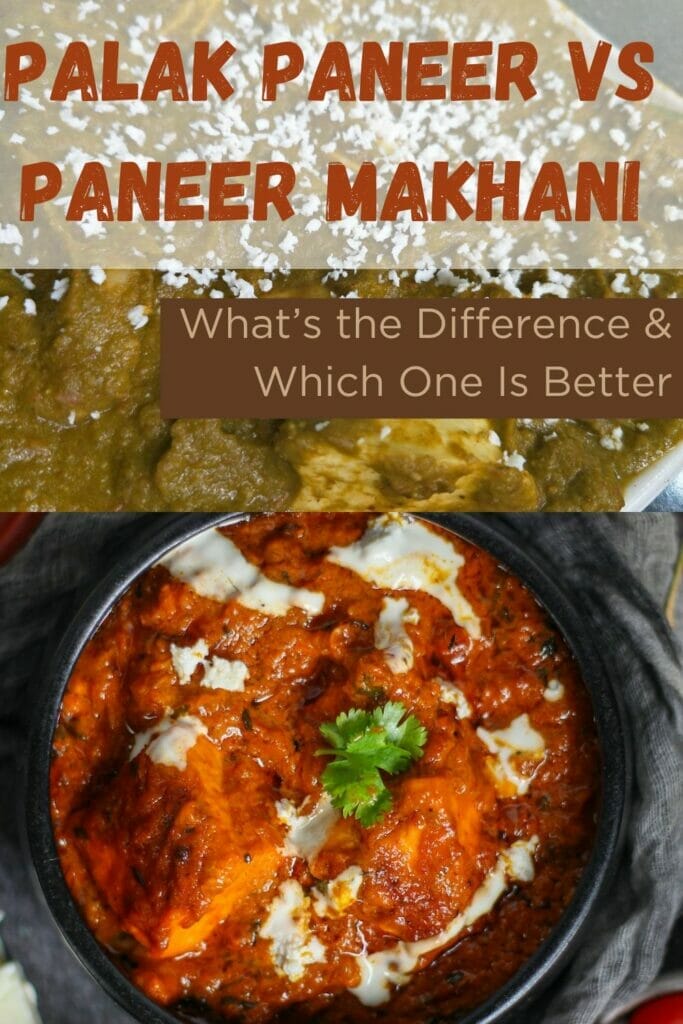
Table Showing the Differences Between Palak Paneer and Paneer Makhani
| Factors | Palak Paneer | Paneer Makhani |
|---|---|---|
| Origin | North Indian cuisine | Punjabi cuisine |
| Color | Vibrant green | Orange-red |
| Flavor | Earthy, mildly spiced | Tangy, slightly sweet |
| Texture | Smooth and creamy | Rich and velvety |
| Ingredients | Spinach, paneer, spices | Tomatoes, paneer, spices |
| Availability of Ingredients | Widely available | Widely available |
| Paneer Used | Firm and fresh | Soft and creamy |
| Cooking Time | Shorter | Longer |
| Method of Cooking | Spinach pureed with spices | Tomato-based gravy simmered with spices |
| Serving | Main course with naan, roti, or rice | Main course with naan, roti, or rice |
| Nutritional Value (Approximate Values per Serving) | ||
| Calories | Varies | Varies |
| Protein | Varies | Varies |
| Carbohydrates | Varies | Varies |
| Fiber | Varies | Varies |
A Brief Overview of Palak Paneer

Picture a vibrant green dish that combines the goodness of spinach with the creaminess of paneer (Indian cottage cheese). Palak Paneer is a classic North Indian recipe that has won over countless palates across the globe. Its rich and flavorful taste makes it a favorite among vegetarians and even those who enjoy non-vegetarian dishes.
In this dish, fresh spinach leaves are blanched and pureed to create a velvety, emerald-green base. The spinach puree is then cooked with aromatic spices like cumin, coriander, and garam masala, which infuse the dish with a delightful fragrance.
Cubes of paneer are gently added to the simmering spinach gravy, allowing them to soak up the flavors and become soft and succulent.
Palak Paneer not only satisfies your taste buds but also offers a host of health benefits. Spinach, the star ingredient, is packed with essential nutrients like iron, calcium, vitamins A and C, and dietary fiber. It’s a perfect dish for those looking to incorporate greens into their diet without compromising on taste.
A Brief Overview of Paneer Makhani:
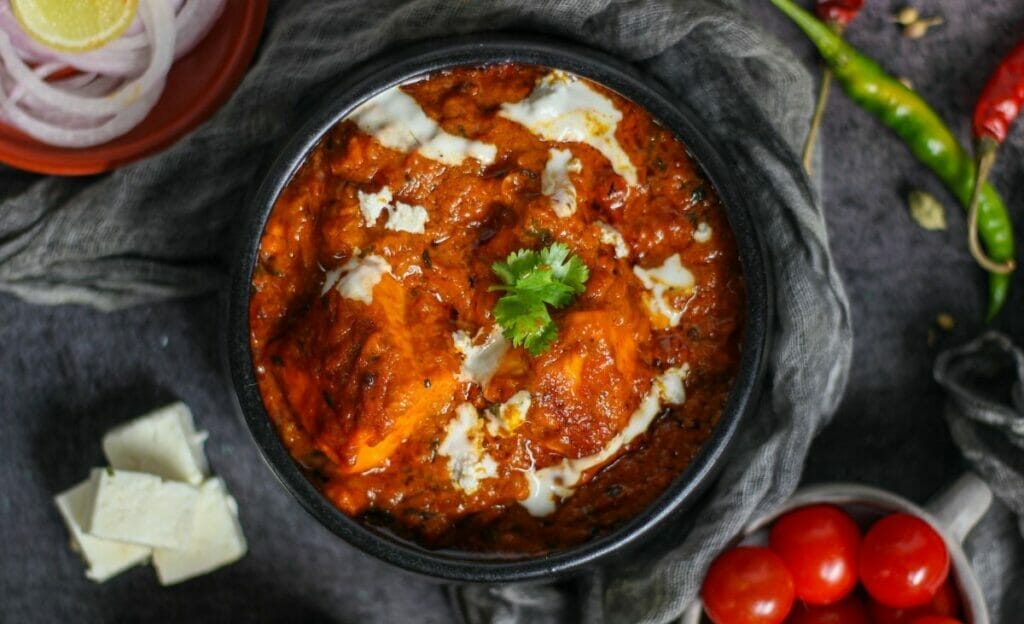
Now that we’ve covered Palak Paneer, let’s shift our focus to another mouthwatering dish: Paneer Makhani, also known as Butter Paneer or Paneer Butter Masala. This rich and indulgent preparation hails from the Punjabi cuisine of Northern India and is a favorite in many Indian households and restaurants worldwide.
Paneer Makhani boasts a vibrant tomato-based gravy that is infused with aromatic spices, a touch of sweetness, and a generous dose of butter and cream.
The gravy is prepared by simmering ripe tomatoes with onions, ginger, garlic, and a blend of spices like cumin, turmeric, and red chili powder. This slow-cooked process allows the flavors to meld together, resulting in a luscious and velvety texture.
The star of the show, paneer, is added to the creamy tomato gravy, absorbing the flavors and becoming melt-in-your-mouth tender. The combination of rich tomato sauce, fragrant spices, and the creamy texture of paneer creates a harmony of flavors that is sure to leave you craving for more.
Paneer Makhani is a true crowd-pleaser and pairs wonderfully with naan, roti, or fragrant basmati rice. This dish is perfect for those seeking a comforting and indulgent meal that showcases the essence of Indian cuisine.
Difference between Palak Paneer and Paneer makhani (Detailed breakdown)
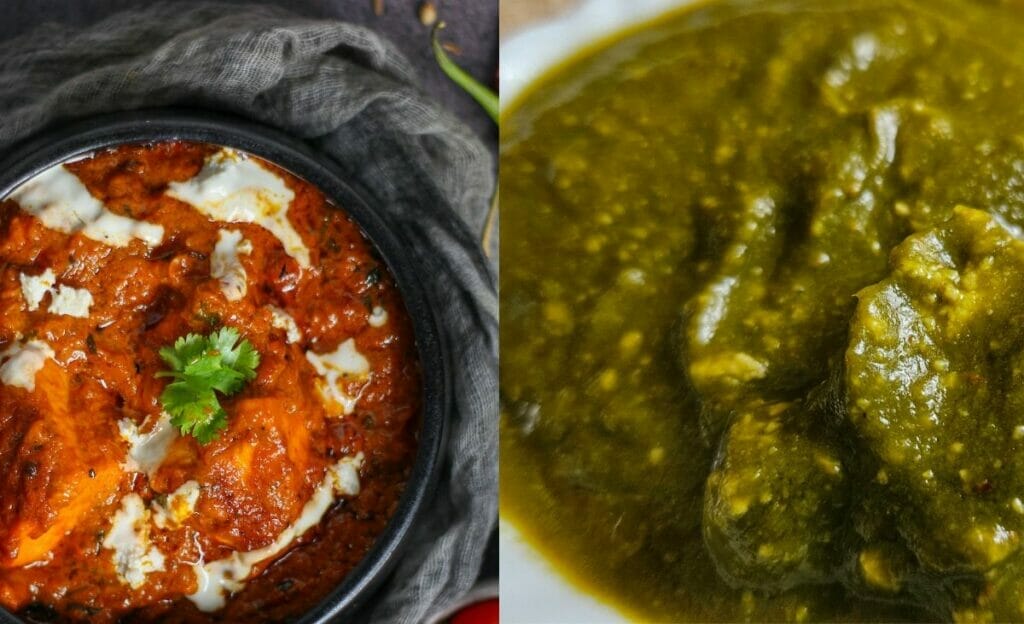
Now, let’s dive into the specifics and explore the intriguing differences between these two delectable dishes.
Differences in Origin:
Let’s start with a peek into the origins of Palak Paneer and Paneer Makhani. Palak Paneer, a North Indian delicacy, finds its roots in the rich culinary heritage of the region. It showcases the perfect marriage of spinach and paneer, which is a soft Indian cottage cheese.
On the other hand, Paneer Makhani, also known as Butter Paneer or Paneer Butter Masala, hails from the vibrant Punjabi cuisine of Northern India. It features a creamy tomato-based gravy, generously adorned with aromatic spices.
Differences in Color:
When it comes to color, these two dishes couldn’t be more distinct. Palak Paneer boasts a vibrant and appetizing green hue that captures the essence of fresh spinach leaves. The vibrant emerald color of the spinach puree in Palak Paneer is not only visually appealing but also represents the nutritional powerhouse that spinach is.
In contrast, Paneer Makhani showcases a warm and inviting orange-red color, thanks to its luscious tomato-based gravy. The combination of ripe tomatoes and a blend of spices imparts a beautiful color to the dish, making it a feast for both the eyes and the taste buds.
Differences in Flavor:
Now, let’s turn our attention to the exciting world of flavors. Palak Paneer tantalizes your taste buds with its earthy and mildly spiced notes. The creamy texture of paneer beautifully balances the vibrant flavors of the spinach gravy, resulting in a harmonious combination. With every bite, you’ll experience a burst of freshness from the spinach, along with the rich creaminess of paneer.
On the other hand, Paneer Makhani takes you on a flavorful joyride of tangy and slightly sweet notes. The tomato-based gravy, enriched with butter and cream, creates a velvety and indulgent texture.
The blend of aromatic spices enhances the savory profile, while the creaminess of paneer adds a luxurious touch. Each mouthful of Paneer Makhani leaves you craving for more, with its rich, complex flavors dancing on your palate.
Difference in Texture:
When it comes to texture, Palak Paneer and Paneer Makhani offer distinct experiences. Palak Paneer delights with its smooth and creamy consistency. The velvety spinach puree, coupled with the softness of paneer cubes, creates a delightful melt-in-your-mouth sensation. Each bite is a balance of lush creaminess and the tender bite of paneer.
In contrast, Paneer Makhani takes on a richer and more indulgent texture. The creamy tomato-based gravy, generously enriched with butter and cream, results in a velvety smoothness that coats your palate. The paneer in Paneer Makhani absorbs the flavors of the gravy, becoming incredibly soft and luxurious. Every spoonful offers a luxurious and velvety experience that’s sure to satisfy your cravings.
Difference in Ingredients:
The magic of Indian cuisine lies in its array of spices and ingredients. Let’s take a closer look at the differences in ingredients between Palak Paneer and Paneer Makhani.
Palak Paneer features the vibrant combination of spinach and paneer as its star ingredients. Fresh spinach leaves are blanched and pureed to create a luscious green base.
Paneer, the beloved Indian cottage cheese, is added to the spinach gravy, complementing its flavors and creating a satisfying dish. Along with these key ingredients, a medley of spices like cumin, coriander, garam masala, and turmeric enhances the overall taste profile.
Paneer Makhani, on the other hand, showcases the irresistible marriage of paneer and a rich tomato-based gravy. The gravy is created by simmering ripe tomatoes with onions, ginger, garlic, and a blend of spices that often include cumin, coriander, turmeric, garam masala, and red chili powder.
Butter and cream lend a creamy and indulgent touch to the dish, taking its flavors to another level of decadence.
Difference in Availability of Ingredients:
When it comes to ingredient availability, both dishes are relatively accessible, though some variations may exist based on regional availability.
Spinach, a key ingredient in Palak Paneer, is widely available in grocery stores and local markets throughout the year. Paneer, too, can be found in many stores specializing in Indian cuisine or in the cheese section of well-stocked supermarkets.
For Paneer Makhani, ripe tomatoes are the primary ingredient. Tomatoes are usually readily available in most markets and grocery stores, making it convenient to whip up this delightful dish. Paneer, as mentioned earlier, is also easily obtainable.
The spices used in both dishes, such as cumin, coriander, turmeric, and garam masala, are staples in Indian cooking and can be found in most spice sections or specialty stores.
Difference in the Paneer Used:
Let’s start with the star ingredient—paneer! In Palak Paneer, the paneer used is typically firm and fresh. The firmness allows it to retain its shape during the cooking process while still becoming soft and succulent. Fresh paneer is ideal for absorbing the flavors of the spinach gravy and melding beautifully with the dish.
In Paneer Makhani, the paneer used is often soft and creamy. The softness of the paneer complements the rich and velvety tomato-based gravy. It easily absorbs the flavors of the spices and becomes incredibly tender, melting in your mouth with each bite. The creamy paneer adds a luxurious touch to the overall texture of the dish.
Difference in Cooking Time:
The cooking time for Palak Paneer and Paneer Makhani can vary, as each dish follows a distinct cooking process.
Palak Paneer requires a relatively shorter cooking time. Once the spinach is blanched and pureed, it is cooked with the spices for a few minutes to allow the flavors to meld together.
The paneer is added towards the end and simmered gently, ensuring it absorbs the essence of the dish without overcooking. This shorter cooking time helps retain the vibrant green color and the freshness of the spinach.
On the other hand, Paneer Makhani involves a slightly longer cooking process. The tomato-based gravy is slow-cooked to allow the flavors to develop and intensify. The spices, onions, and tomatoes simmer together, infusing the gravy with their aromatic goodness.
The paneer is added later, allowing it to absorb the flavors while maintaining its delicate texture. The longer cooking time of Paneer Makhani helps create a rich, deep flavor profile.
Difference in Method of Cooking:
The method of cooking also sets these dishes apart, adding to their unique characteristics.
In Palak Paneer, the spinach is blanched, cooled, and pureed before being incorporated into the dish. The spices are tempered in hot oil or ghee to release their flavors, and the spinach puree is then added to the mixture. The paneer cubes are gently cooked in the spinach gravy, ensuring they absorb the flavors while retaining their softness. The result is a harmonious blend of creamy spinach and tender paneer.
Paneer Makhani, on the other hand, involves a multi-step process. The spices are first sautéed in hot oil or ghee to enhance their flavors. Onions, ginger, and garlic are added, followed by ripe tomatoes. The mixture is cooked until the tomatoes break down and release their juices.
The mixture is then pureed, creating a smooth tomato-based gravy. Butter and cream are added for richness, and the paneer is gently cooked in the luscious gravy, allowing it to soak up the flavors.
Difference in Serving:
When it comes to serving, Palak Paneer and Paneer Makhani present distinct styles that add to their culinary appeal.
Palak Paneer is typically served as a main course dish, accompanied by naan, roti, or fragrant basmati rice. The creamy green spinach gravy, adorned with tender paneer cubes, is often garnished with a drizzle of cream or a sprinkle of chopped coriander leaves.
The vibrant presentation of Palak Paneer makes it a visually enticing centerpiece on the dining table.
On the other hand, Paneer Makhani is often served as a luxurious and indulgent dish. It is commonly enjoyed as a main course, served alongside naan, roti, or steamed rice.
The rich and velvety tomato-based gravy, generously coating the soft paneer cubes, creates a visual and culinary feast. Paneer Makhani is often garnished with a dollop of butter and a sprinkle of fresh coriander leaves, adding to its irresistible allure.
Difference in Nutritional Value:
Let’s take a closer look at the nutritional value of Palak Paneer and Paneer Makhani, considering key aspects like calories, protein, carbohydrates, and fiber.
Palak Paneer is a nutritious choice for those seeking a wholesome and flavorful dish. Spinach, the star ingredient, is packed with essential nutrients like iron, calcium, vitamins A and C, and dietary fiber. Paneer contributes to the dish’s protein content, making it a satisfying vegetarian option.
The overall calorie content of Palak Paneer can vary depending on factors such as the amount of oil or cream used in the recipe.
Paneer Makhani, while indulgent, also offers nutritional benefits. Paneer is a rich source of protein and provides satiety. The tomatoes in the gravy are a great source of vitamins A and C, while the spices used in the recipe add flavor without adding significant calories. However, due to the presence of butter and cream, Paneer Makhani tends to have a higher calorie content compared to Palak Paneer.
It’s important to note that the exact nutritional values may vary based on the specific recipe and ingredients used. Additionally, portion sizes and individual dietary needs should be taken into consideration.
Similarities Between Palak Paneer and Paneer makhani
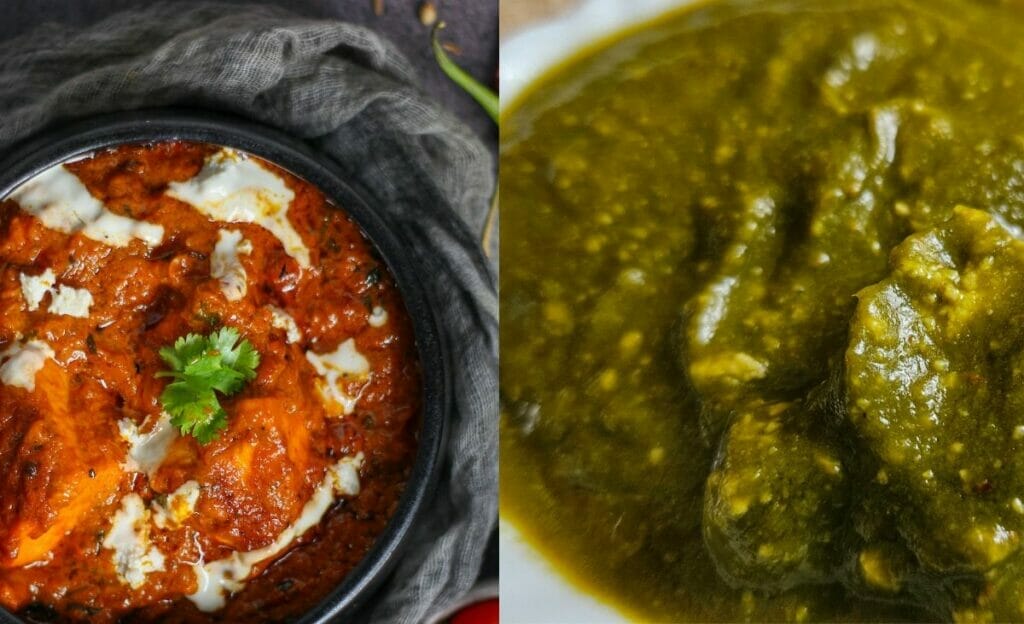
While Palak Paneer and Paneer makhani have their own unique flavors and characteristics, there are a few delightful similarities that bring them together. So, let’s delve into the details and discover the common threads between these culinary gems!
Similarity #1: The Star Ingredient – Paneer:
Paneer takes center stage in both Palak Paneer and Paneer Makhani. This soft and creamy Indian cottage cheese adds a luxurious and protein-rich element to both dishes. Whether it’s simmering gently in the vibrant spinach gravy of Palak Paneer or absorbing the flavors of the velvety tomato-based sauce in Paneer Makhani, paneer shines as the hero ingredient, bringing its delicate texture and subtle richness to the table.
Similarity #2: Vegetarian Delights:
Both Palak Paneer and Paneer Makhani cater to vegetarian preferences, making them popular choices for those seeking meatless options. These dishes showcase the versatility and deliciousness of vegetarian cuisine, providing a satisfying and flavorful experience for vegetarians and non-vegetarians alike.
With paneer as the star, these dishes prove that vegetarian fare can be just as indulgent and satisfying as meat-based dishes.
Similarity #3: Aromatic Spices:
Indian cuisine is renowned for its vibrant and aromatic spices, and both Palak Paneer and Paneer Makhani embrace this tradition. While the specific spice combinations may vary slightly, both dishes incorporate a blend of spices that enhance the overall flavor profile.
Common spices like cumin, coriander, turmeric, garam masala, and red chili powder infuse the dishes with a delightful complexity, adding depth and warmth to every mouthful.
Similarity #4: Creaminess and Indulgence:
Palak Paneer and Paneer Makhani share a common thread of luxurious creaminess. In Palak Paneer, the creaminess comes from the smooth spinach gravy, which envelops the paneer cubes in a velvety texture.
Paneer Makhani, on the other hand, boasts a rich and indulgent tomato-based gravy, generously enriched with butter and cream. The result? A heavenly creaminess that elevates the dining experience and leaves you craving more.
Similarity #5: Adaptable Accompaniments:
Both Palak Paneer and Paneer Makhani pair beautifully with a variety of accompaniments. Whether you prefer naan, roti, paratha, or fragrant basmati rice, these dishes are versatile enough to be enjoyed with your choice of bread or rice.
The creamy gravies of Palak Paneer and Paneer Makhani create a perfect harmony with the textures and flavors of these traditional Indian staples, allowing you to savor every bite to the fullest.
Conclusion:
While Palak Paneer and Paneer Makhani have their own distinct flavors and characteristics, they share several delightful similarities that make them beloved dishes in Indian cuisine. From the star ingredient of paneer to the aromatic spices and indulgent creaminess, these dishes offer a culinary experience that delights the taste buds and satisfies the soul.
So, whether you find yourself craving the vibrant freshness of Palak Paneer or the rich velvety goodness of Paneer Makhani, rest assured that both dishes embody the essence of Indian cuisine and provide a memorable dining experience.
Embrace the similarities, explore the flavors, and indulge in the magic of Palak Paneer and Paneer Makhani. Happy cooking and happy feasting!
Tips for Making Palak Paneer:

Select Fresh and Vibrant Spinach:
When making Palak Paneer, opt for fresh spinach leaves with vibrant green color. Ensure that the leaves are clean, free from any wilting or discoloration. This will ensure a vibrant and flavorful spinach puree for your dish.
Blanch and Shock the Spinach:
To retain the vibrant green color of the spinach, blanch the leaves in boiling water for a brief moment and then transfer them to an ice bath. This process, known as blanching and shocking, helps preserve the color and ensures a vibrant green base for your Palak Paneer.
Don’t Overcook the Spinach:
While simmering the spinach with spices, take care not to overcook it. Overcooking can result in loss of color and a dull taste. Keep the cooking time minimal to retain the fresh flavor and vibrant green hue of the spinach.
Gently Cook the Paneer:
When adding paneer to the Palak Paneer gravy, make sure to cook it gently to maintain its soft and delicate texture. Simmer the paneer cubes for a short duration, allowing them to absorb the flavors of the dish without becoming too firm or rubbery.
Tips for Making Paneer Makhani:

Use Ripe and Juicy Tomatoes:
Choose ripe and juicy tomatoes for Paneer Makhani. The quality of tomatoes will greatly impact the taste and richness of the gravy. Look for tomatoes that are firm, with a vibrant red color and a sweet aroma.
Slow-Cook the Gravy:
To develop the rich flavors in Paneer Makhani, slow-cook the tomato-based gravy on a low to medium heat. This allows the tomatoes, onions, and spices to meld together, resulting in a depth of flavor that enhances the overall dish.
Balance Creaminess and Tanginess:
The creaminess of Paneer Makhani is essential to its character. However, striking a balance between the creaminess and tanginess is crucial. Add butter and cream gradually, tasting as you go, to achieve the desired creamy and tangy flavor profile without overpowering one element over the other.
Add Paneer at the Right Time:
Add paneer cubes to the Paneer Makhani gravy towards the end of the cooking process. This ensures that the paneer absorbs the flavors of the sauce without becoming overly soft or breaking apart. Gently simmer the paneer in the gravy for a short duration to infuse it with the deliciousness of the dish.
How to make Palak Paneer recipe (Video)
How to make Paneer makhani recipe (Video)
FAQ
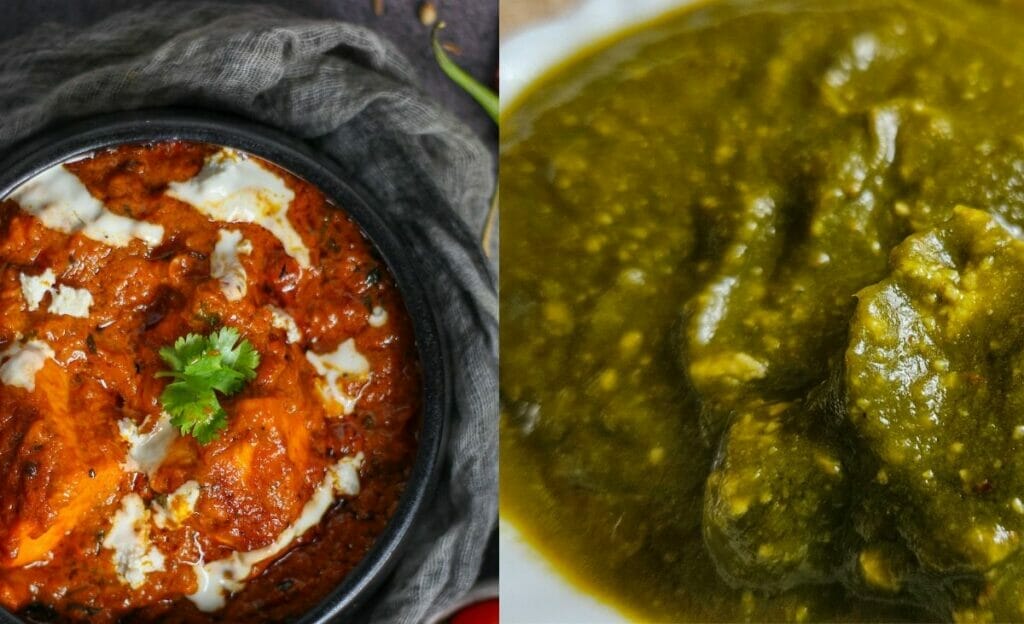
Is Paneer Makhani the Same as Butter Paneer?
Ah, the question of similarity! Paneer Makhani and Butter Paneer are indeed similar dishes. In fact, they are often used interchangeably. Both dishes feature paneer in a rich, creamy tomato-based gravy, with butter playing a prominent role in enhancing the flavors. The terms “Paneer Makhani” and “Butter Paneer” refer to the same concept—creamy, buttery goodness combined with paneer.
Which is Better: Shahi Paneer or Paneer Makhani?
Ah, the battle of the royal dishes! Shahi Paneer and Paneer Makhani are both indulgent and luxurious options. Shahi Paneer is a rich, creamy dish prepared with a cashew and cream-based gravy, while Paneer Makhani features a tomato-based gravy enriched with butter and cream.
The choice between the two ultimately depends on personal preference. If you enjoy the richness of cashews and cream, Shahi Paneer might be your go-to. However, if you’re a fan of the tangy and velvety tomato flavors with a hint of butter, Paneer Makhani will be your delight.
What is the Difference between Paneer Makhani and Butter Masala?
Paneer Makhani and Butter Masala are often used synonymously to describe similar dishes. The key difference lies in the base flavors. Paneer Makhani showcases the rich tanginess of tomatoes, while Butter Masala emphasizes the creamy and buttery notes. Both dishes feature a luscious paneer gravy, with the distinction being the dominant flavors of tangy tomatoes or rich butter.
What’s the Difference between Paneer Makhani and Paneer Tikka Masala?
Paneer Makhani and Paneer Tikka Masala are distinct dishes, each with its own character. Paneer Makhani highlights a creamy tomato-based gravy with soft paneer, while Paneer Tikka Masala showcases marinated and grilled paneer in a spiced tomato-based gravy.
Paneer Tikka Masala offers a smoky and slightly charred flavor profile due to the grilling process, while Paneer Makhani delights with its velvety texture and tangy tomato notes. The choice between the two depends on your preference for grilled paneer or a creamier texture.
Is Paneer Makhani Sweet or Spicy?
Paneer Makhani strikes a balance between sweet and mildly spicy flavors. The natural sweetness of ripe tomatoes combined with aromatic spices creates a pleasant and slightly sweet taste. The spices, such as cumin, coriander, and garam masala, infuse the dish with gentle warmth and a touch of spiciness. The overall flavor profile is harmonious, with the sweetness of tomatoes complementing the subtle spice levels.
Is Makhani Like Tikka Masala?
Makhani and Tikka Masala share similarities in terms of their tomato-based gravies, but they differ in preparation and flavors. Makhani gravies are typically made with cashew or cream, resulting in a velvety, rich texture.
On the other hand, Tikka Masala gravies are spicier and showcase a distinct flavor profile from the use of specific spices. While they share the tomato base, the balance of flavors and the overall experience are unique to each dish.
What are the Other Names for Paneer Makhani?
Paneer Makhani is known by various names in different regions. It is often referred to as Butter Paneer, Paneer Butter Masala, or Shahi Paneer. These names allude to the dish’s creamy, buttery, and indulgent nature.
What is the Difference between Curry and Makhani?
Curry and Makhani represent different styles of preparation in Indian cuisine. While curry is a generic term used for a variety of dishes with a sauce or gravy base, Makhani refers to a specific type of rich and creamy gravy made with butter, cream, and tomatoes. Makhani gravies are typically smoother and have a velvety texture compared to other curry preparations.
Is Paneer Makhani Fattening?
Paneer Makhani, like many rich and indulgent dishes, can be higher in calories due to the use of butter and cream. However, it is important to remember that enjoying such dishes in moderation, as part of a balanced diet, can be a delightful treat. If you’re watching your calorie intake, you can opt for lighter versions of Paneer Makhani by reducing the amount of butter and cream used.
Palak Paneer vs Paneer Tikka Masala: What’s the difference?
Palak Paneer and Paneer Tikka Masala offer distinct culinary experiences. Palak Paneer showcases a vibrant green spinach gravy with paneer, providing a refreshing and earthy flavor profile. Paneer Tikka Masala, on the other hand, features grilled paneer in a spiced tomato-based gravy, offering a smoky and robust taste. The choice between the two depends on your preference for green and refreshing or smoky and spiced flavors.
Does Makhani Mean Butter?
Yes, indeed! “Makhani” translates to “buttery” in Hindi. The term signifies the use of butter in the dish, adding richness and depth of flavor to the gravy. So, when you come across “Makhani” in a dish name, you can expect a delectable touch of butteriness.
What Does Makhani Sauce Taste Like?
Makhani sauce is known for its rich, velvety texture and its delightful blend of tangy and mildly sweet flavors. The base of tomatoes, combined with butter, cream, and aromatic spices, creates a luxurious and smooth taste experience. The flavors are well-balanced, with a hint of tanginess from the tomatoes and a touch of sweetness and creaminess from the butter and cream.
Paneer Butter Masala vs Paneer Makhani: What’s the difference?
Paneer Butter Masala and Paneer Makhani are often used interchangeably to describe similar dishes. Both feature a creamy tomato-based gravy with paneer and a touch of butter. While some variations may exist in terms of specific ingredients and preparation techniques, the overall experience of indulging in these dishes is rich, creamy, and buttery.
Shahi Paneer vs Paneer Makhani: What’s the difference?
Shahi Paneer and Paneer Makhani are both regal dishes that offer luxurious flavors. Shahi Paneer features a cashew and cream-based gravy, creating a creamy and nutty taste.
Paneer Makhani, on the other hand, showcases a tomato-based gravy with butter and cream, resulting in a tangy and velvety experience. The choice between the two depends on your preference for a cashew-cream richness or a tangy, buttery delight.
Which is Spicier: Palak Paneer vs Paneer Makhani?
When it comes to spice levels, Palak Paneer tends to be milder compared to Paneer Makhani. Palak Paneer focuses more on earthy flavors with a gentle touch of spices, while Paneer Makhani strikes a balance between mild spiciness and tanginess from the tomatoes. If you prefer a milder spice profile, Palak Paneer might be your go-to, while those seeking a slightly spicier kick can opt for Paneer Makhani.
Which is Healthier: Palak Paneer vs Paneer Makhani?
Both Palak Paneer and Paneer Makhani offer nutritional benefits, but the healthier option depends on individual dietary preferences and requirements. Palak Paneer packs the goodness of spinach, which is rich in iron, calcium, vitamins, and dietary fiber. It provides a wholesome and nutrient-dense option.
Paneer Makhani, although indulgent with its butter and cream, still offers protein from the paneer and vitamins from the tomatoes. If you’re watching your calorie intake, you can choose lighter versions of both dishes by reducing the amount of oil, butter, and cream used in their preparation.
Which is Better: Palak Paneer vs Paneer Makhani?
Determining which dish is better, Palak Paneer or Paneer Makhani, ultimately comes down to personal preference. Palak Paneer delights with its vibrant green colors, refreshing flavors, and the health benefits of spinach. It’s a fantastic choice for those seeking a nutritious and lighter option.
Paneer Makhani, on the other hand, offers a rich and indulgent experience with its creamy tomato-based gravy, accentuated by butter and cream. It’s perfect for those looking to treat themselves to a luxurious meal. Both dishes have their unique charm, so go ahead and try them both to discover your personal favorite!
Conclusion
In conclusion, the world of Indian cuisine offers a delightful array of flavors and textures, as exemplified by Palak Paneer and Paneer Makhani. These two iconic dishes have captivated food lovers with their distinct characteristics, from the vibrant green hues and earthy flavors of Palak Paneer to the rich and creamy indulgence of Paneer Makhani.
Throughout this article, we’ve explored the differences in origin, color, flavor, texture, ingredients, cooking time, method of cooking, serving styles, and nutritional values of these dishes.
We’ve also unraveled the intriguing debates surrounding them, such as the similarities between Paneer Makhani and Butter Paneer, the difference between Paneer Makhani and Butter Masala, and the spiciness of Palak Paneer vs Paneer Makhani, among many other engaging topics.
By understanding these nuances, you’ll be better equipped to appreciate and create these culinary wonders in your own kitchen. Whether you prefer the vibrant freshness of Palak Paneer or the luxurious creaminess of Paneer Makhani, both dishes promise to tantalize your taste buds and leave you craving more.
So, don’t miss out on the wealth of information we’ve covered in this article. From tips for making Palak Paneer and Paneer Makhani to the similarities between the dishes, we’ve provided valuable insights to help you become a master of these beloved Indian delicacies.
So, dive into the article and unlock the secrets of Palak Paneer and Paneer Makhani. Embrace the flavors, experiment with spices, and embark on a culinary journey that will transport you to the heart of Indian cuisine. Happy cooking and enjoy the delightful feast that awaits you!
Remember, food is not just about nourishment, but also about exploring diverse cultures and creating memorable experiences. So, get ready to savor the magic of Palak Paneer and Paneer Makhani. Happy reading and happy cooking!
Related articles:
- Palak Paneer vs Paneer Butter Masala (Comparing the Green and Creamy Paneer Delights)
- Palak Paneer vs Matar Paneer (Decoding the Classic Paneer Showdown)
- Palak Paneer vs Paneer Tikka Masala: From Creamy Greens to Smoky Grills
- Palak Paneer vs Shahi Paneer: Unveiling the Culinary Contrast
- Palak Paneer vs Saag Paneer: Decoding the Green Dilemma
